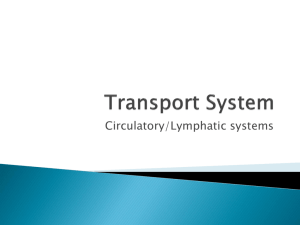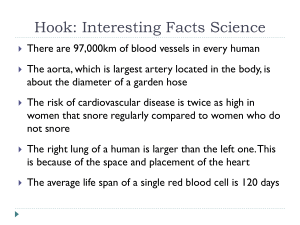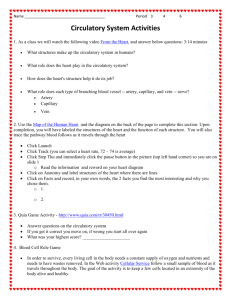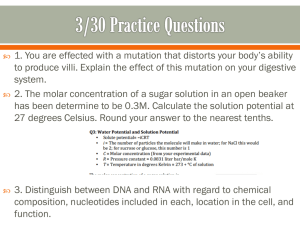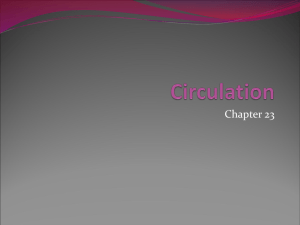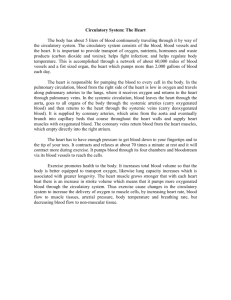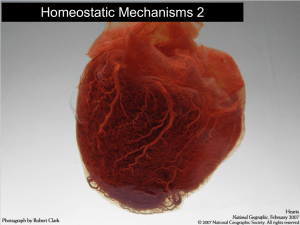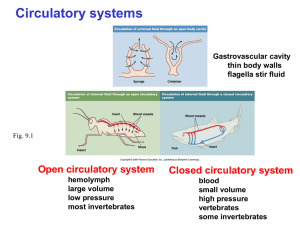Circulation and Gas Exchange
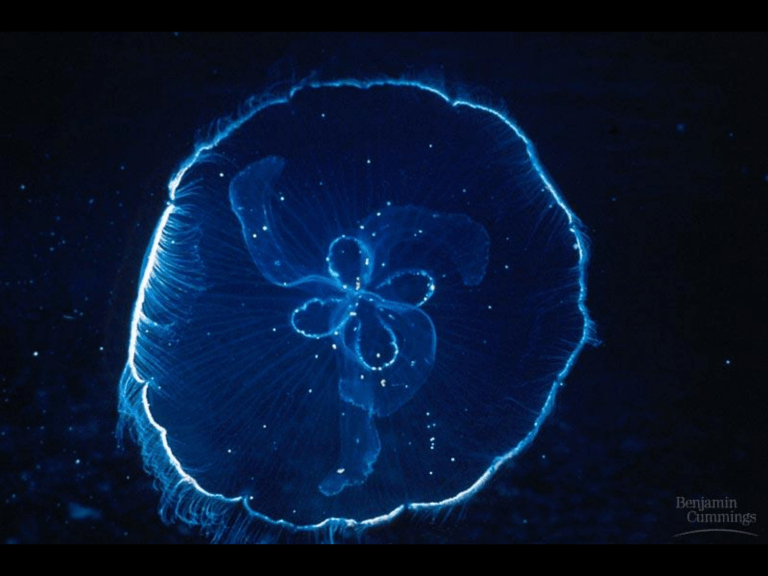
Learning Objectives:
Circulation in Animals
(2/20/09)
1. Compare the different methods of internal transport of body fluids within the context of maintaining homeostasis.
2. Differentiate between open and closed circulatory systems, with examples.
3. Compare and contrast the structure and function of mammalian arteries, veins and capillaries.
4. Discuss the forces involved in the exchange of materials between capillaries and the interstitial fluid.
5. Describe the evolution of separate pulmonary and systemic circuits in vertebrates.
6. Compare extrinsic and intrinsic regulation of cardiac function.
This section begins on p. 994
Mechanisms of Transport in Organisms
(review)
• Diffusion , by molecular motion
– good only at short distances,
• Pump, Channel and Carrier mediated transport
– small molecules across membranes,
• Osmosis (water movement across membranes)
• Bulk Flow
– efficient large-scale, mass movement
– hydrostatic pressure
Fick’s Law and Organisms
Average time for a molecule (solute, gas, or water) to move a set distance (L)...
Directly proportional to the distance squared!
t c
=
L 2
D s p. 982
The branching gastrovascular cavity of Cnidaria
• Does this animal have distinct boundary organs?
• Name one other animal that has a gastrovascular cavity.
• Explain why Cnidaria don’t need a separate circulatory system.
Embryonic development of circulatory systems in invertebrates
Note that the coelom in arthropods is present, but much reduced. Explain why the coelom is relatively large in annelids.
Open vs. Closed Circulatory Systems
• How is hemolymph different from blood?
See also p. 995
• Describe the difference in fluid pressure and volume between open and closed circulatory systems.
Structure of Blood Vessels
Compare pressures in arteries, veins, and capillaries.
How is blood flow accomplished in veins?
In which tissues would you expect to find the most capillaries?
p. 996
Bulk Flow
Jean Louis Marie Poiseuille (Poiseuille’s Law, ~1838)
…the concentrated movement of groups of molecules,
• in biological systems, most often in response to pressure
• directly proportional to the diameter of the tube and the pressure gradient
• inversely proportional to the viscosity of the fluid and the distance the fluid must travel (due to frictional forces) pressure gradient
Volume flow rate = in a cylinder p r 4
8 h
DY p
D x viscosity ( h) distance
Increase Flow?
Increase radius…
How does this affect resistance?
Lower Viscosity…
Is this a likely mechanism?
Increase Pressure…
How would this be accomplished?
Volume flow rate = p r 4
8 h
DY p
D x pressure gradient viscosity ( h) distance
Label the arrows to show the net direction of water movement by
1. hydrostatic
(filtration) pressure
1. osmosis
Label the diagram to explain the net direction of this bulk flow.
What conditions might change the rate of filtration or osmosis?
Do capillaries ever change their porosity?
Tissue Fluid Formation and Return
Transport across a capillary wall
Name one plasma protein that helps maintain the osmolarity of blood plasma.
Evolution of the
Vertebrate Heart
• Heart forms as a tube in all vertebrate embryos – with 4 “chambers” in a series:
(tail end) sinus venosus atrium ventricle
truncus arteriosus
(head end)
This is the circulatory scheme in bony fish
• In the embryo, contraction first begins in the ventricle. Why?
– Later, the atria begin to beat, but at a faster rate.
Sig?
Which chamber receives blood first?
p. 998
Pumps in Circulation
Two alternative methods, both create challenges:
• If the pump is used to deliver blood with force to the gas exchange organ, little force remains to distribute the oxygenated blood to the tissues.
•
Name one type of animal with this circulatory scheme.
• How is the problem “handled”?
•If the pump is used to deliver blood with force to the tissues, little force remains to send the deoxygenated blood to the gas exchange organ.
•
How have birds and mammals handled this problem?
Evolution of pulmonary and systemic circuits in vertebrates
• How is the four chambered heart in endotherms related to temperature homeostasis?
• How is the function of the pulmonary circuit different from the function of the systemic circuit?
http://users.rcn.com/jkimball.ma.ultranet/BiologyPages/A/AnimalHearts.html
Most fishes have never solved this “problem”, which is probably why most of them are poikilothermic with relatively low aerobic capacity.
Venous return is facilitated by body movements.
While obviously adequate, this is not a very efficient system.
The pressure generated by contraction of the ventricle is almost entirely dissipated when the blood enters the gills.
This group of marine invertebrates has solved the problem by having separate pumps:
The Squid Hearts
(cephalopods)
* two gill (branchial) hearts to force blood under pressure to the gills
* a systemic heart to force blood under pressure to the rest of the body.
How does this adaptation relate to the lifestyle of cephalopods?
The Mammalian
Cardiovascular
System
Trace the pathway of a single red blood cell, beginning at the right atrium.
What causes the valves in the heart to close?
What mechanisms enable blood to be returned to the heart?
Cardiac cycle
Describe the mechanical (physical) events in one cardiac cycle.
What feature of heart muscle is necessary for this coordinated function?
The Cardiac Conduction System
Why are there nerves that innervate the heart?
What chemical messages affect heart action?
p. 1002
